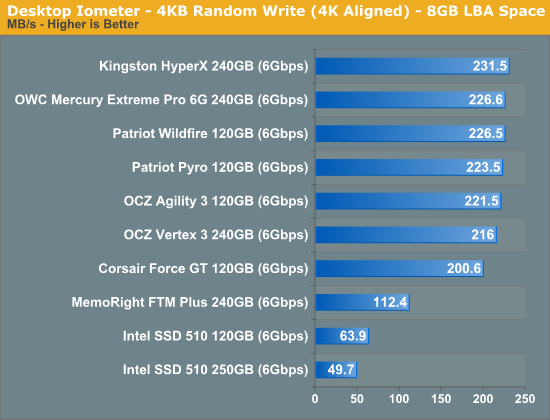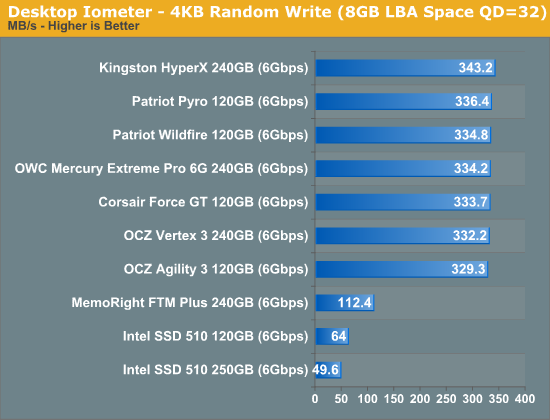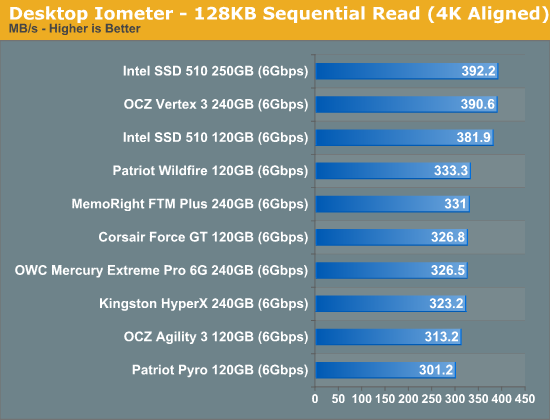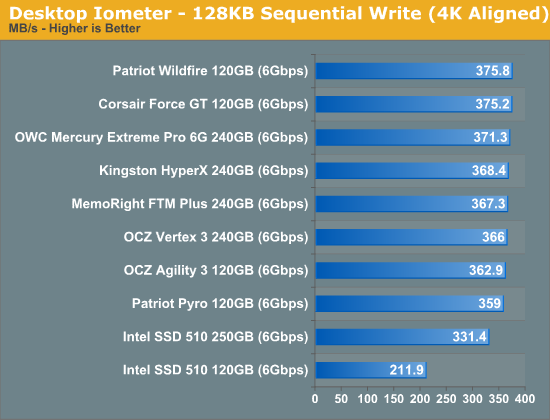The SandForce Roundup: Corsair, Kingston, Patriot, OCZ, OWC & MemoRight SSDs Compared
by Anand Lal Shimpi on August 11, 2011 12:01 AM ESTRandom Read/Write Speed
The four corners of SSD performance are as follows: random read, random write, sequential read and sequential write speed. Random accesses are generally small in size, while sequential accesses tend to be larger and thus we have the four Iometer tests we use in all of our reviews.
Our first test writes 4KB in a completely random pattern over an 8GB space of the drive to simulate the sort of random access that you'd see on an OS drive (even this is more stressful than a normal desktop user would see). I perform three concurrent IOs and run the test for 3 minutes. The results reported are in average MB/s over the entire time. We use both standard pseudo randomly generated data for each write as well as fully random data to show you both the maximum and minimum performance offered by SandForce based drives in these tests. The average performance of SF drives will likely be somewhere in between the two values for each drive you see in the graphs. For an understanding of why this matters, read our original SandForce article.

Random read performance is pretty consistent across all of the SF-2281 drives. The Patriot drives lose a bit of performance thanks to their choice in NAND (asynchronous IMFT in the case of the Pyro and Toggle NAND in the case of the Wildfire).

Most random writes are highly compressible and thus all of the SF-2281 drives do very well here. There's no real advantage to synchronous vs. asynchronous NAND here since most of the writes never make it to NAND in the first place. The Agility 3 and Vertex 3 here both use their original firmware while the newer drives are running the latest firmware updates from SandForce. The result is a slight gain in performance, but all things equal you won't see a difference in performance between these drives.
The MemoRight FTM Plus is the only exception here. Its firmware caps peak random write performance over an extended period of time. This is a trick you may remember from the SF-1200 days. It's almost entirely gone from the SF-2281 drives we've reviewed. The performance cap here will almost never surface in real world performance. Based on what we've seen, if you can sustain more than 50MB/s in random writes you're golden for desktop workloads. The advantage SandForce drives have is they tend to maintain these performance levels better than other controllers thanks to their real-time compression/dedupe logic.
Many of you have asked for random write performance at higher queue depths. What I have below is our 4KB random write test performed at a queue depth of 32 instead of 3. While the vast majority of desktop usage models experience queue depths of 0 - 5, higher depths are possible in heavy I/O (and multi-user) workloads:

All of the SF-2281 drives do better with a heavier load. The MemoRight drive is still capped at around 112MB/s here.
Sequential Read/Write Speed
To measure sequential performance I ran a 1 minute long 128KB sequential test over the entire span of the drive at a queue depth of 1. The results reported are in average MB/s over the entire test length.

The older SF-2281 firmwares did a bit better in some tests than the newer versions, hence the Vertex 3 being at the top here. All of the newer drives perform pretty similarly in our sequential read test.

The same goes for our sequential write test - all of the SF-2281 drives perform very similarly.










90 Comments
View All Comments
arklab - Thursday, August 11, 2011 - link
A pity you didn't get the new ... err revised OWC 240GB Mercury EXTREME™ Pro 6G SSD.It now uses the SandForce 2282 controller.
While said to be similar to the troubled 2281, I'm wondering if it is different enough to side step the BSOD bug.
It may well also be faster - at least by a bit.
Only the 240GB has the new controller, not there 120GB - though the 480 will also be getting it "soon".
PLEASE get one, test, and add to this review!
cigar3tte - Thursday, August 11, 2011 - link
Anand mentioned that he didn't see any BSOD's with the 240GB drives he passed out. AFAIK, only the 120GB drives have the problem.Also, the BSOD is only when you are running the OS on the drive. So if you have the drive as an addon, you'd just lose the drive, but no BSOD, I believe.
I returned my 120GB Corsair Force 3 and got a 64GB Micro Center SSD (the first SandForce controller) instead.
jcompagner - Sunday, August 14, 2011 - link
ehh,, i have one of the first 240GB vertex 3 in my Dell XPS17 sandy bridge laptop.with the first firmware 2.02 i didn't get BSOD after i got Windows 7 64bit installed right (using the intel drivers, fixing the LPM settings in the registry)
everything was working quite right
then we got 2 firmware version who where horrible BSOD almost any other day. Then we get 2.09 which OCZ says thats a bit of an debug/intermediate release not really a final release. And what is the end result? ROCK STABLE!! no BSOD at all anymore.
But then came the 2.11 release they stressed that everybody should upgrade and also upgrade to the latest 10.6 intel drivers.. I thought ok lets do it then.
In 2 weeks: 3 BSOD, at least 2 of them where those F6 errors again..
Now i think it is possible to go back to 2.09 again, which i am planing to do if i got 1 more hang/BSOD ...
geek4life!! - Thursday, August 11, 2011 - link
I thought OCZ purchasing Indilnx was to have their own drives made "In house".To my knowledge they already have some drives out that use the Indilnx controller with more to come in the future.
I would like your take on this Anand ?
zepi - Thursday, August 11, 2011 - link
How about digging deeper into SSD behavior in server usage?What kind of penalties can be expected if daring admins use couple of SSD's in a raid for database / exchange storage? Or should one expect problems if you run a truckload of virtual machines from reasonably priced a raid-5 of MLC-SSD's ?
Does the lack of trim-support in raid kill the performance and which drivers are the best etc?
cactusdog - Thursday, August 11, 2011 - link
Great review but Why wouldnt you use the latest RST driver? Supposed to fix some issues.Bill Thomas - Thursday, August 11, 2011 - link
What's your take on the new EdgeTech Boost SSD's?ThomasHRB - Thursday, August 11, 2011 - link
Thanks for another great article Anand, I love reading all the articles on this site. I noticed that you have also managed to see the BSOD issues that others are having.I don't know if my situation is related, but from personal experience and a bit of trial and error I found that by unstable power seems to be related to the frequency of these BSOD events. I recently built a new system while I was on holiday in Brisbane Australia.
Basic Specs:
Mainboard - Gigabyte GA-Z68X-UD3R-B3
Graphics - Gigabyte GV-N580UD-15I
CPU - Intel Core i72600K (stock clock)
Cooler - Corsair H60 (great for computer running in countries where ambient temp regularly reach 35degrees Celsius)
PSU -Corsair TX750
In Brisbane my machine ran stable for 2 solid weeks (no shutdown's only restart during software installations, OS updates etc).
However when I got back to Fiji, and powered up my machine, I had these BSOD's every day or 2 (I shutdown my machine during the days when I am at work and at night when I am asleep) (CPU temp never exceeded 55degrees C measured with CoreTemp and RealTemp) and GPU temp also never went above 60degrees C measured with nvidia gadget from addgadget.com)
All my computer's sit behind an APC Back-UPS RS (BR1500). I also have an Onkyo TX-NR609 hooked up to the HDMI-mini port, so I disconnected that for a few days, but i saw no differences.
However last Friday, a major power spike caused my Broadband router (dlink DIR-300) to crash, and I had to reset the unit to get it working. My machine also had a BSOD at that exact same moment. so I thought that it was a possibility that I was getting a power spike being transmitted through the Ethernet cable from my ISP (the only thing that I have not got an isolation unit for)
So the next day I bough and installed an APC ProtectNET (PNET1GB) and I have not had a single BSOD running for almost 1 full week (no shutdown's and my Onkyo has been hooked back up).
Although this narrative is long and reflects nothing more than my personal experiences, I at least found it strange that my BSOD seems to have nothing to do with the Vertex3 and more to do with random power fluctuations in my living environment.
And it may be possible that other people are having the same problem I had, and attributing it to a particular piece of hardware simply because other people have done the same attribution.
Kind Regards.
Thomas Rodgers
etamin - Thursday, August 11, 2011 - link
Great article! The only thing that's holding me back from buying an SSD is that secure data erasing is difficult on an SSD and a full rewrite of the drive is neither time efficient nor helpful to the longevity of the drive...or so I have heard from a few other sources. What is your take on this secure deletion dilemma (if it actually exists)?lyeoh - Friday, August 12, 2011 - link
AFAIK erasing a "conventional" 1 TB drive is not very practical either ( takes about 3 hours).Options:
a) Use encryption, refer to the "noncompressible" benchmarks, use the more reliable SSDs, and use hardware acceleration or fast CPUs e.g. http://www.truecrypt.org/docs/?s=hardware-accelera...
b) Use physical destruction - e.g. thermite, throwing it into lava, etc :).